2,000 Years of Global Growth in 6 Minutes
Published on February 18th, 2016
The NGO Population Connection (formerly Zero Population Growth or ZPG) has produced an outstanding, visually arresting 6-minute video that graphically dramatizes the population explosion humanity and our Earth have experienced in the last two centuries.
Actually, the video shows 2,000+ years of demographic history, but during most of that time little appears to happen. It is only after 1800 (the 19th century), and especially after 1900 (the 20th century), that the pace of growth suddenly becomes eye-popping. And that unsustainable, eye-popping pace continues at present.
At the outset, as we see a spinning, life-nurturing Planet Earth, the narrator intones:
“The capacity of our environment to provide space, to produce food, and to supply energy are all limited….We depend on these limited resources for our survival, yet we are increasing our population as if they were infinite. This fact is at the core of our environmental problems.”
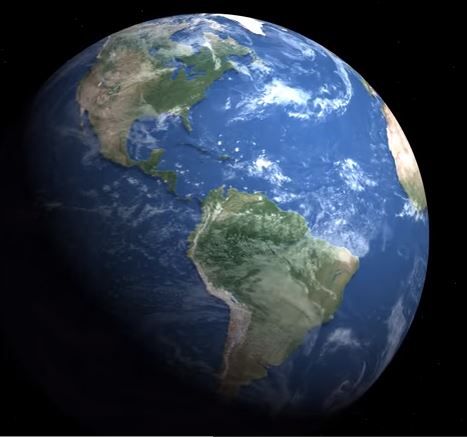 |
| In The Beginning – Earth was an orb in the black void of space teeming with all manner of life. |
At the time our common ancestors – an upstart, bipedal ape later named Homo sapiens – began their long march out of African savannas toward Eurasia, and ultimately the islands of Oceania and the Americas – the “peopling of the planet” as it has been called – the Earth was teeming with all manner of life. Unfortunately, hundreds of species of birds and mammals could not withstand the onslaught of this clever and tenacious, tool-shaping and using hunter; these hapless creatures were wiped out, permanently erased into the oblivion of extinction.
Paleontologists and archeologists have painstakingly revealed that our human ancestors, even before the advent of agriculture and even with quite low population densities, had already exterminated a good many marvelous species of feathered and furred critters around the globe. Then when our hunter and gatherer forbears became pastoralists and farmers – the “Agricultural Revolution” – human population surged upwards, yet at rates and amounts that were miniscule molehills compared with today’s mountainous population growth.
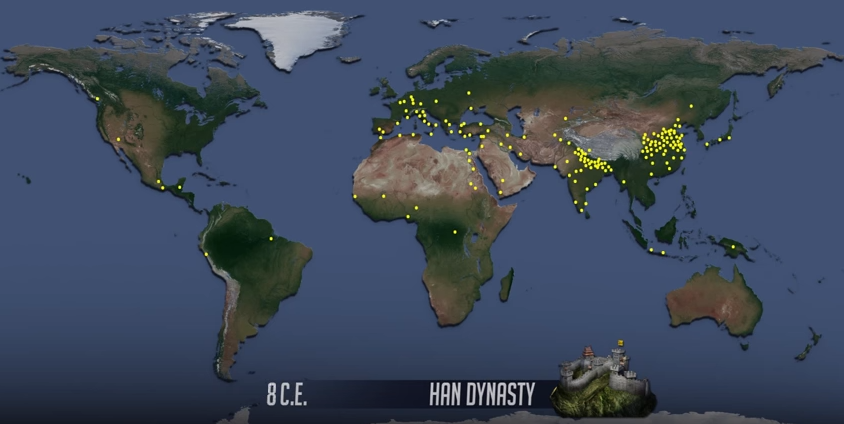 |
| Global population density and distribution in the year 8 C.E. (Common Era or A.D.); each yellow dot represents 1 million people. |
At the start of start of the video’s population progression – the year 8 C.E. (Common Era or A.D.) – the Han Dynasty rules over China. This is essentially the time of Jesus Christ, some 2,000 years ago. There were approximately a couple of hundred million people living on the entire planet, less than 3 percent of the current global population. We can see that even 2,000 years ago, populous China and India were already the most densely populated places on Earth, with Europe a distant third. North America (including Mexico and Central America) had perhaps 5 million widely dispersed residents.
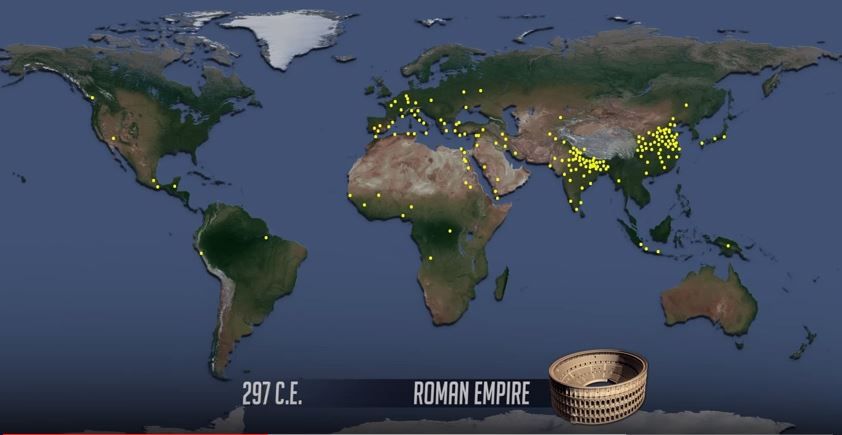 |
| Global population density and distribution in the year 297 C.E. |
By 297 C.E., things appear little changed. The Western Roman Empire is in its waning days, and chaos and disintegration threaten its decadent realm. But overall, in Africa, Asia, Australia and the Americas, human life continues much as it has for millennia, and world population is only slightly larger than it was three centuries earlier. North and South America combined boast a modest 7 million residents or so. Rates of population growth were so tiny that the change in population size from one generation to the next, or one century to the next, was all but imperceptible.
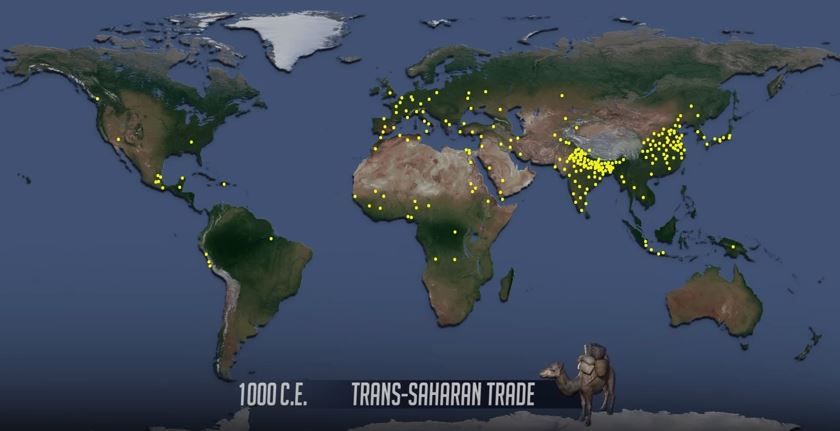 |
| Global population density and distribution in the year 1000 C.E. |
Jumping ahead seven centuries all the way to the year 1000 C.E., the rate of population growth has become noticeably faster, but still a snail’s pace compared to today’s. The number of people in the Americas has doubled to about 15 million, but it took 700 years to accomplish this doubling. In the 20th century, the population of the Americas doubled in less than 40 years.
In what is now the United States and Canada combined, there are a mere 3 million indigenous residents, less than 1 percent of the 360 million at present.
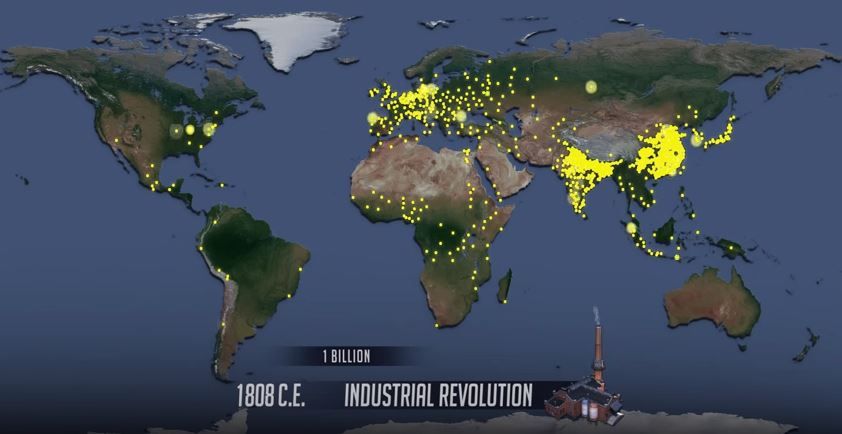 |
| Global population density and distribution in the year 1808 C.E. |
Moving forward another eight centuries, to the year 1800 or thereabouts, human beings finally reach the milestone of 1 billion, after tens of thousands of years of slow, steady growth, with a few setbacks from epidemics like the Black Death in the 1300s. The growth rate has begun to accelerate in recent centuries, but it is about to become dizzying with the Scientific and Industrial Revolutions and the colossal exploitation of fossil fuels, increased food production and improved life expectancy these made possible.
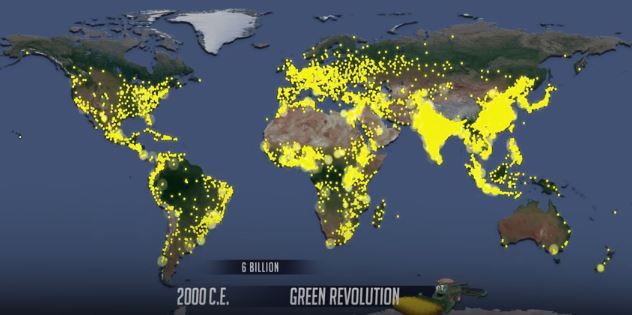 |
| Global population density and distribution in the year 2000 C.E. |
By 2000, the end of the second millennium, the so-called Green Revolution, a sort of advanced Agricultural Revolution (breeding of high-yield crops, and use of inputs such as fertilizers, pesticides and irrigation water to agriculture), helped us avoided mass starvation and contributed to a global population of about 6 billion. And now we are at 7.4 billion and counting.
At present, demographers foresee no end in sight to growth, that is, no population peak, even out to the year 2100.
However, they may be wrong though, because their model projections assume that there will always be enough food, water, resources and a benign climate – that none of these will become limiting alone or in combination. That is, demographers and economists assume that the environment and the Earth are but a passive stage upon which humanity struts its stuff. But all of these assumptions are dubious at best, given what agricultural scientists, hydrologists, geologists and climatologists tell us.
In other words, humanity’s demographic destiny may be out of our hands. It is – and always was – rank hubris to believe that humans alone can choose how large our presence and how heavy our demands on the planet will be, and that limits to growth imposed by the Earth itself have no bearing on this choice.




